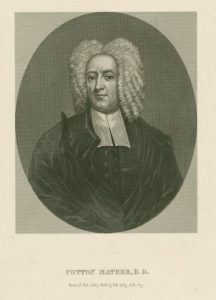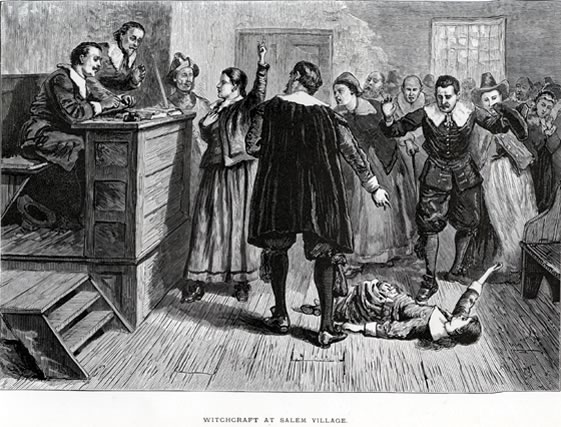44 Author Introduction-Cotton Mather (1663-1728)
Various Authors
MATHER, COTTON (1663-1728), American Congregational clergyman and author, was born in Boston, Massachusetts, on the 12th of February 1663. He was the grandson of Richard Mather, and the eldest child

of Increase Mather (q.v.), and Maria, daughter of John Cotton. After studying under the famous Ezekiel Cheever (1614-1708), he entered Harvard College at twelve, and graduated in 1678. While teaching (1678-1685), he began the study of theology, but soon, on account of an impediment in his speech, discontinued it and took up medicine. Later, however, he conquered the difficulty and finished his preparation for the ministry. He was elected assistant pastor in his father’s church, the North, or Second, Church of Boston, in 1681 and was ordained as his father’s colleague in 1685. In 1688, when his father went to England as agent for the colony, he was left at twenty-five in charge of the largest congregation in New England, and he ministered to it for the rest of his
life. He soon became one of the most influential men in the colonies. He had much to do with the witchcraft persecution of his day; in 1692 when the magistrates appealed to the Boston clergy for advice in regard to the witchcraft cases in Salem he drafted their reply, upon which the prosecutions were based; in 1689 he had written Memorable Providences Relating to Witchcraft and Possessions, and even his earlier diaries have many entries showing his belief in diabolical possession and his fear and hatred of it. Thinking as he did that the New World had been the undisturbed realm of Satan before the settlements were made in Massachusetts, he considered it natural that the Devil should make a peculiar effort to bring moral destruction on these godly invaders. He used prayer and fasting to deliver himself from evil enchantment; and when he saw ecstatic and mystical visions promising him the Lord’s help and great usefulness in the Lord’s work, he feared that these revelations might be of diabolic origin. He used his great influence to bring the suspected persons to trial and punishment. He attended the trials, investigated many of the cases himself, and wrote sermons on witchcraft, the Memorable Providences and The Wonders of the Invisible World (1693), which increased the excitement of the people. Accordingly, when the persecutions ceased and the reaction set in, much of the blame was laid upon him; the influence of Judge Samuel Sewall, after he had come to think his part in the Salem delusion a great mistake, was turned against the Mathers; and the liberal leaders of Congregationalism in Boston, notably the Brattles, found this a vulnerable point in Cotton Mather’s armour and used their knowledge to much effect, notably by assisting Robert Calef (d. c. 1723) in the preparation of More Wonders of tlte Invisible World (1700) a powerful criticism of Cotton Mather’s part in the delusion at Salem.
Mather took some part as adviser in the Revolution of 1689 in Massachusetts. In 1690 he became a member ot the Corporation (probably the youngest ever chosen as Fellow) of Harvard College, and in 1707 he was greatly disappointed at his failure to be chosen president of that institution. He received the degree of D.D. from the University of Glasgow in 1710, and in 1713 was made a Fellow of the Royal Society. Like his father he was deeply grieved by the liberal theology and Church polity of the new Brattle Street Congregation, and conscientiously opposed its pastor Benjamin Colman, who had been irregularly ordained in England and by a Presbyterian body; but with his father he took part in 1700 in services in Colman’s church. Harvard College was now controlled by the Liberals of the Brattle Street Church, and as it grew farther and farther away from Calvinism, Mather looked with increasing favour upon the college in Connecticut; before September 1701 he had drawn up a “scheme for a college,” the oldest document now in the Yale archives; and finally (Jan. 1718) he wrote to a London merchant, Elihu Yale, and persuaded him to make a liberal gift to the college, which was named in his honour. During the smallpox epidemic of 1721 he attempted in vain to have treatment by inoculation employed, for the first time in America; and for this he was bitterly attacked on all sides, and his life was at one time in danger; but, nevertheless, he used the treatment on his son, who recovered, and he wrote An Account of the Method and further Success of Inoculating for the Small Pox in London(1721). In addition he advocated temperance, missions, Bible societies, and the education of the negro; favoured the establishing of libraries for working men and of religious organizations for young people, and organized societies for other branches of philanthropic work. His later years were clouded with many sorrows and disappointments; his relations with Governor Joseph Dudley were unfriendly; he lost much of his former prestige in the Church — his own congregation dwindled — and in the college; his uncle John Cotton was expelled from his charge in the Plymouth Church; his son Increase turned out a ne’er-do-well; four of his children and his second wife died in November 1713; his wife’s brothers and the husbands of his sisters were ungodly and violent men; his favourite daughter Katherine, who “understood Latin and read Hebrew fluently,” died in 1716; his third wife went mad in 1719; his personal enemies circulated incredible scandals about him; and in 1724-1725 he saw a Liberal once more preferred to him as a new president of Harvard. He died in Boston on the 13th of February 1728 and is buried in the Copps Hill burial-ground, Boston. He was thrice married — to Abigail Phillips (d. 1702) in 1686, to Mrs Elizabeth Hubbard (d. 1713) in 1703, and in 1715 to Mrs Lydia George (d. 1734). Of his fifteen children only two survived him.
Among his four hundred or more published works, many of which are sermons, tracts and letters, the most notable is his Magnalia Christi Americana: or the Ecclesiastical History of New England,from Its First Planting in the Year 1620 unto the Year of Our Lord, 1698. Begun in 1693 and finished in 1697, this work was published in London, in 1702, in one volume, and was republished in Hartford in 1820 and in 1853-1855, in two volumes. It is in seven books and concerns itself mainly with the settlement and religious history of New England. It is often inaccurate, and it abounds in far-fetched conceits and odd and pedantic features. Its style, though in the main rather unnatural and declamatory, is at its best spontaneous, dignified and rhythmical; the book is valuable for occasional facts and for its picture of the times, and it did much to make Mather the most eminent American writer of his day. His other writings include A Poem Dedicated to the Memory of the Reverend and Excellent Mr Urian Oakes (1682); The Present State of New England (1690); The Life of the Renowned John Eliot (1691), later included in Book III. of the Magnalia; The Short History of New England (1694); Bonifacius, usually known as Essays To Do Good (Boston, 1710; Glasgow, 1825; Boston, 1845), one of his principal books and one which had a shaping influence on the life of Benjamin Franklin; Psalterium Americanum (1718), a blank verse translation of the Psalms from the original Hebrew; The Christian Philosopher: A Collection of the Best Discoveries in Nature, with Religious Improvements (1721); Parentator (1724), a memoir of his father; Ratio Disciplinae (1726), an account of the discipline in New England churches; Manuductio ad Ministerium: Directions for a Candidate of the Ministry (1726), one of the most readable of his books. He also left a number of works in manuscript, including diaries, a medical treatise and a huge commentary on the Bible, entitled “Biblia Americana.”

Figure 2. Artist Rendering of Salem Witch Trial Scene, Created 1875
Source:
1911 Encyclopaedia Britannica/ Mather, Cotton. Public Domain.
Image Credit:
Figure 1. “Cotton Mather,” Artist Unknown, New York Public Library, Likely Public Domain, No Known Restrictions.
Figure 2. “Artist Rendering of Salem Witch Trial Scene, Created 1875,” William A. Crafts, Wikimedia, Public Domain.

